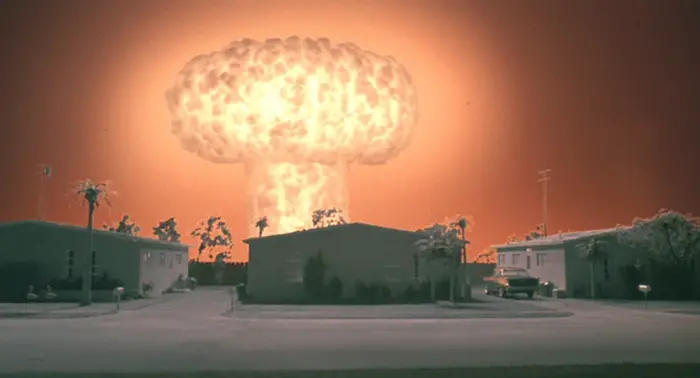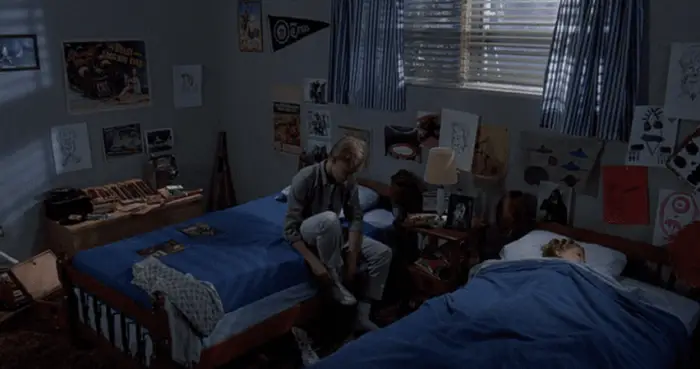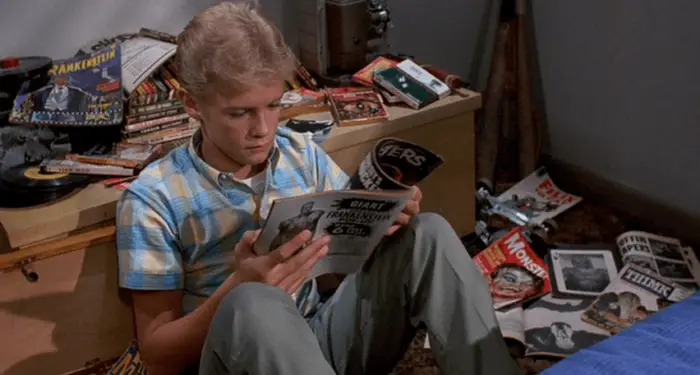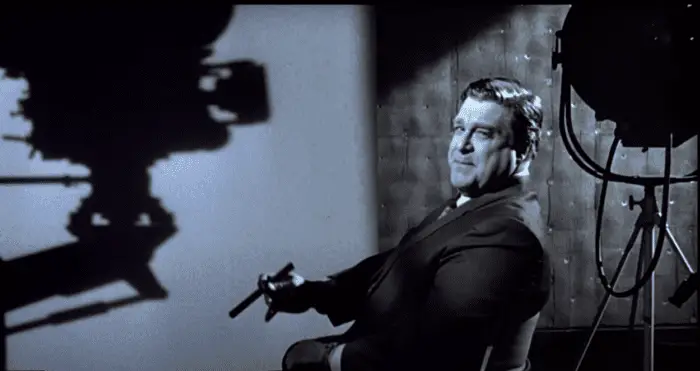Few filmmakers could pull off what director Joe Dante and writer Charlie Haas accomplish in Matinee (1993), and even fewer could do so with such apparent ease. Set in Key West, Florida, during the Cuban Missile Crisis of October 1962, the film stars John Goodman as the fictitious Lawrence Woolsey, a monster-movie maker who specializes in theatrical gimmicks. Woolsey has arrived in town to unveil a sneak preview of his latest feature capitalizing on the fear of the atomic bomb: Mant! As the portmanteau word indicates, his new monster is a mutated ant-man, the result of radiation exposure to an ant and a man simultaneously. What’s more, Mant! will be presented in Woolsey’s “AtomoVision” process. Matinee is told through the eyes of fifteen-year-old Gene Loomis (Simon Fenton), a fan of horror and science-fiction, who lives on a local naval base with his mother and younger brother while his father is on submarine duty.

On the one hand, the film is a clever satire on American hucksterism, the sort that fueled the promotion for and exhibition of low-budget genre films during the middle of the twentieth century. Alfred Hitchcock famously mandated that theaters refuse admission to patrons who arrived after the start time of Psycho (1960), lest the surprises—most notably the twist ending—be spoiled for them. King of ballyhoo William Castle promised that his monster movie The Tingler (1959) would rely on something he called “Percepto”; this meant that exhibitors had to wire select seats with buzzers that would give members of the audience a jolt at a key moment in the film when the creature was supposed to have gotten loose in the theater.
On the other hand, Matinee is also a warm-hearted celebration of neighborhood moviegoing before the era of corporate-owned multiplexes. Even as it gently parodies “giant bug” movies like The Fly (1958), The Deadly Mantis (1957), Tarantula! (1955), and Them! (1954, the title referring to giant ants), it acknowledges the real communal pleasures they offered. Woolsey may be a humbug artist and a shameless opportunist, but you can’t help but admire his commitment to showmanship. So, while the humor of Matinee is incisive, it never stoops to mean-spirited mockery, and for all of its affectionate period details, it resists indulging in overly sentimental nostalgia. The film treats atomic destruction as a serious threat that looms large in the lives of the characters.

Joe Dante’s personal connection to the material partly accounts for this level of sensitivity. A director of his own fair share of monster movies, among them Piranha (1978), The Howling (1981, one of the best werewolf flicks this side of Lon Chaney Jr.), Gremlins (1984), and Gremlins 2: The New Batch (1990), Dante grew up as a “monster kid” and was the same age as Gene in 1962. This was the heyday of fan magazines such as Famous Monsters of Filmland and Castle of Frankenstein (he was a reader and later a contributor to both), and his own magazines, collectibles, and drawings from the period are on display in Gene’s bedroom. In 2007, Dante co-created Trailers from Hell, a web series dedicated to historical commentary on genre films, in certain respects following the lead of those 1960s fan-magazine publishers who shaped him.


As a filmmaker, Dante’s style combines old-fashioned horror and science fiction with a self-reflexive, cartoon-like sensibility that ranges from darkly comic to fully absurd. In Gremlins 2, for example, the reptilian hellraisers interrupt a television broadcast of Leonard Maltin panning the first Gremlins and make mincemeat of the helpless film critic (a good sport about it, Maltin plays himself in the scene). Later, they invade a movie theater showing Gremlins 2, break the film strip, proceed to make shadow puppets on the screen, and then temporarily replace the film with footage of nude women playing volleyball! It’s a gag worthy of vintage Warner Bros. animation, and also pays homage to William Castle’s theater stunts. In the alternate version of this sequence for the home-video release, the gremlins appear to jam the tape and change the television channels before settling on a John Wayne western they have “taken over.”
If Matinee doesn’t hew to the slapstick-infused anarchy of the Gremlins films, its sense of humor still comes from the same pop cinephilia. Dante gets some of the biggest laughs in the film from the film-within-the-film. Mant! includes appearances by actors Robert Cornthwaite (the villainous scientist in The Thing from Another World [1951]), Kevin McCarthy (the hero in Invasion of the Body Snatchers [1956]), and William Schallert (the father on ABC’s The Patty Duke Show [1963-1966]).
Movie and television buffs may recognize other familiar faces in Matinee. Writer-director John Sayles (the writer of Piranha and script doctor on The Howling) and Dante regular Dick Miller both play two of Woolsey’s associates. A not-yet-famous Naomi Watts stars in the banal, Disneyesque family comedy The Shook-Up Shopping Cart, a movie to which Gene is subjected at the local theater. Veteran character actor Jesse White (the “Ol’ Lonely” repairman from Maytag commercials) received his final screen credit as the owner of the theater chain. And Charlie Haas, the screenwriter of both Matinee and Gremlins 2, makes a cameo as a health teacher, who pontificates on the virtues of a red-meat diet only to show up later in a grocery store fighting with another customer over the last box of shredded wheat.
On the note of casting, the film’s talented ensemble gives each of the supporting characters their own distinct story and personality that we catch in glimpses from Gene’s perspective. There’s Cathy Moriarty as Woolsey’s cynical actress-girlfriend Ruth, Omri Katz as Gene’s buddy Stan, Kellie Martin as Stan’s crush Sherry, Lisa Jakub as new girl Sandra (the daughter of liberal parents, who speaks out against the futility of school’s “duck and cover” bomb drills), James Villemaire as juvenile delinquent and wannabe poet Harvey Starkweather (who shares a surname with late-1950s serial killer Charles Starkweather), Robert Picardo as the harried theater manager, and Lucinda Jenney and Jesse Lee as Gene’s mother and younger brother, respectively.
For the film to work, though, it needs an actor like John Goodman to play Woolsey. With that twinkle in his eyes and scrapper’s determination, Woolsey is the kind of guy you like and even root for despite knowing he’s full of flimflam. He looks like Hitchcock, but his gimmicks were explicitly inspired by Castle (Woolsey’s “AtomoVision” also involves installing buzzers under seats). If we are to believe that Woolsey—like Hitchcock and Castle—would have had an audience of reasonably minded people, then we need to be taken in by his hustle, too. Goodman understands that.

Looking back on the film in 2023, as theaters have shuttered, major box-office profits consolidate only around franchise installments, and streaming services continue to provide popular alternatives to going to the movies, this fond remembrance of a certain kind of theatrical experience takes on a bittersweet poignancy. Earlier in January, IndieWire reported that theatrical attendance in 2022 had declined by about 52% of where it was in 2018, suggesting an uncertain future for movie theaters. Ironically, when Matinee was first released in theaters in January of 1993, it turned out to be a box-office failure for Universal Pictures, the studio most identified with classic-era monster fare. Thirty years later, it’s clear that the movies could do with a little of Lawrence Woolsey.
Matinee is available on a collector’s edition Blu-ray from Shout! Factory, and for rental and purchase on demand.



